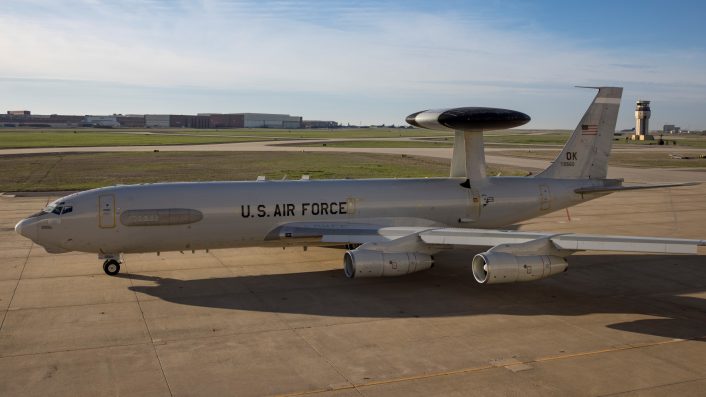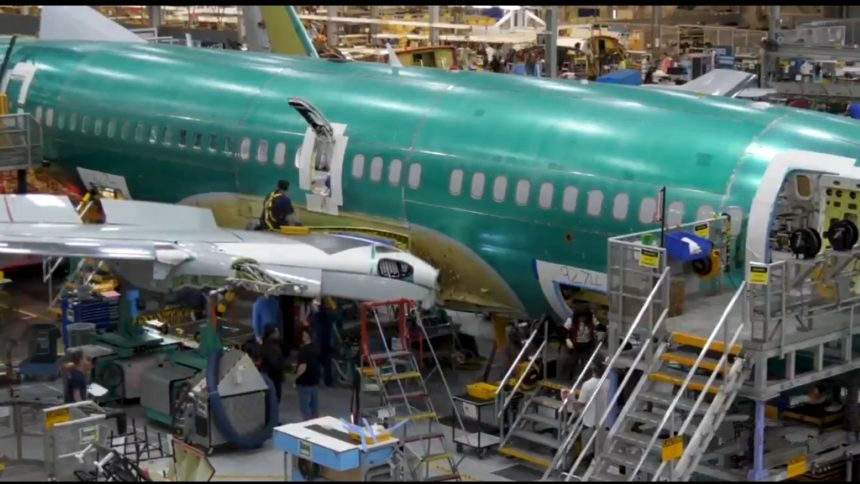The E-3 Sentry is afflicted by acute parts and maintenance issues as the Boeing 707 aircraft it is based on ceased production 30 years ago.
Nearly three months after the fuselage of the U.S. Air Force’s first E-7A Wedgetail AEW&C (Airborne Early Warning and Control) aircraft reached Boeing’s factory in Renton, Washington, Boeing Defense released a video on Apr. 10, 2025 showing that airframe receiving its wings. The short 23-second video showed roof cranes lifting the fuselage and shifting it from one part of the assembly line to the other, placing it between the two wings mounted on jigs, where they are brought closer and connected to the joints.
Adding the vertical fin and horizontal stabilizers would be next, said Boeing. The program is however gradually shaping up at a time when the U.S Air Force and other Allied operators are grappling with keeping their own E-3 Sentry fleet operational, plagued by serviceability issues and low availability rates.
The E-7A Wedgetail is expected to be the U.S. and Allies’ next evolution in joint AEW&C, and is already operated by the Royal Air Force, Royal Australian Air Force, Republic of Korea Air Force, Turkish Air Force and NATO. The aircraft was initially developed for the RAAF, which became the first operator, under “Project Wedgetail.”
The Wedgetail will replace NATO’s fleet of 14 E-3 AWACS (Airborne Early Warning and Control System), with the first delivery scheduled for 2031. Also, on Sep. 20, 2024, the first of three Boeing E-7A Wedgetail AEW&C aircraft of the U.K.’s Royal Air Force completed its first test flight following conversion at Birmingham International Airport.
E-7A gets its wings.
The first @USAirForce E-7A Wedgetail Rapid Prototype was joined with its fuselage and wings. Next up, ➡️ adding vertical fin and horizontal stabilizers. pic.twitter.com/aZEyNmcUQm
— Boeing Defense (@BoeingDefense) April 10, 2025
E-3s being gradually retired
The Air Force chose in 2022 the E-7A Wedgetail to replace the aging E-3 Sentry AWACS, and awarded Boeing a $1.2 billion contract in Feb. 2022 to acquire 26 of the aircraft. The first E-7A being assembled followed a Aug. 9, 2024 $2.56 billion contract to Boeing to rapidly prototype two aircraft.
The older E-3 Sentries account for 16 airframes in the USAF’s fleet, after it already retired 15 units. Based on the out-of-production Boeing 707 passenger airliner, the resulting lack of spares has struck the E-3s with acute maintainability issues.

On Apr. 6, 2023, the USAF retired its first E-3, the airframe 75-0560 assigned to the 552nd Air Control Wing at Tinker AFB in Oklahoma – the same base that received the first E-3 Sentry on Mar. 23, 1977. The airframe then made its way to the “Boneyard” of the 309th Aerospace Maintenance and Regeneration Group at Davis-Monthan AFB in Arizona. The next six months from Apr. 2023 saw 12 more aircraft being divested, and two in 2024, translating into 15 E-3s gone in a year and a half.
The AWACS is also used by Saudi Arabia (5); France (4, designated the E-3F); Japan (4 based on the Boeing 767 platform); and NATO (14). France is also looking to replace its E-3s possibly with Saab’s GlobalEye AEW&C platform.
The United Kingdom is a former user of the AWACS, which the RAF (Royal Air Force) designated as the E-3D and retired in 2021. Three of the RAF aircraft were sold to Chile, with one of them used to harvest spare parts.

E-7A Wedgetail
The E-7 Wedgetail offers a quantum leap in capability over the E-3 Sentry. These include: Airborne Moving Target Indication; Battle Management, Command and Control functions; and a dorsally-located Northrop Grumman Multi-Role Electronically Scanned Array (MESA) primary sensor. The radar provides 360-degree coverage, and is a fixed antenna, unlike the rotating rotodome on the E-3. It is also capable of air-to-surface detection, and has an integrated IFF (Identification Friend or Foe) system.
An open systems architecture and agile software design enable easy and cost-effective upgrades. While the USAF initially considered acquiring a variant of the E-7A Wedgetail adopted by the Royal Air Force according to Defense News, its specific requirements needed more engineering work.
The USAF’s press release about the decommissioning of the first E-3 Sentry called the Boeing E-7A as “the only platform capable of meeting the requirements for the Defense Department’s tactical battle management, command and control and air moving target indicator capabilities.” The 552nd ACW commander Col. Keven Doyle further revealed how US, British and Australian E-7s would function as a “trilateral information and manning exchange” network.
Aussie Wedgetail coming in 21 for Grey Flag 🦘➡️🦅
•
•
9/18/24 | E-7A | #RAAF #Aviation #Military pic.twitter.com/eF7H6HDEtu
— Jaeden Branom (@BranomJaeden) September 23, 2024
E-3 maintainability issues
The War Zone quoted then ACC (Air Combat Command) chief Gen. Mark D. Kelly on the sidelines of the Sep. 2021 iteration of the AFA’s (Air Force Association) annual Air, Space and Cyber conference, who explained the E-3s have “served our nation well.” However, “there’s a reason why exactly zero airlines on the globe fly the 707,” he said. “Because it takes miracle workers every day to just get it up in the air.”
An Apr. 2025 report by Air and Space Forces delved into the specific logistical and technical efforts in keeping the old, yet critical, aircraft flying. A maintainer said how it takes 16 hours “just to get one generated and get in the air,” with inspections alone being the major element, even if the aircraft is not broken. Recurring corrosion problems also necessitate “isochronal inspections” every 18 months.
The E-3’s internal analog and digital components, sensors, miles of wires and communication systems require a maintenance team of Airmen with 11 different Air Force Specialty Codes (AFSCs). This is “three to four times the norm for other USAF airframes,” ASF mentioned.
U.S. Air Force maintainers assigned to the 961st Aircraft Maintenance Unit conduct routine maintenance on an E-3 Sentry AWACS aircraft assigned to the 961st Airborne Air Control Squadron at Kadena Air Base, Japan, Oct. 31, 2023.
(📸/USAF photo by Airman 1st Class Melany Bermudez) pic.twitter.com/Cp7LbGLzpI
— Guy Plopsky (@GuyPlopsky) November 3, 2023
Cannibalizing the aircraft at the ‘Boneyard’ for parts
With the Boeing 707’s production having ended three decades ago and manufacturers of its parts winding down their production lines, the process of sourcing spares acutely complicates. One logistics superintendent said her team has to hire contractors to cannibalize components from the E-3s that have been retired to the “Boneyard” at Davis-Monthan AFB.
ASF added that in 2024 the E-3’s fleet’s mission capable rate stood at just 55.7%. This means fewer than nine E-3s are available on any given day, which is woefully inadequate during wartime.
The parts issue also prompted the AFLCMC (Air Force Life Cycle Management Center) to award a $16.8 million contract to one Plexsys Interface Products Inc. in Feb. 2025 for an “active diminishing manufacturing sources management” project, Military Aerospace Electronics reported. Plexsys is also expected to “provide operation and maintenance, hardware and software updates to fielded AWACS aircraft, distributed mission operations, network mission package updates, and hardware and software support to the 558th Software Engineering Squadron.”









